Schizachyrium scoparium (Little Bluestem)
Morphological Characteristics
by Bob Harms (

)
(This description is restricted to populations in N. Hays County. For a contrast with Bothriochloa ischaemum (King Ranch Bluestem)).
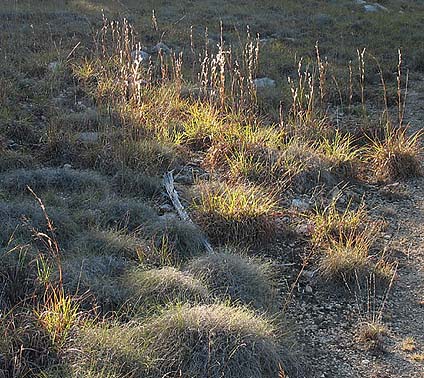 | 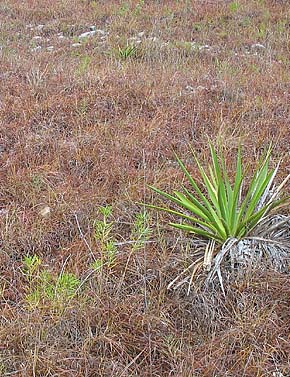 |
Backlit inflorescence.
[Muhlenbergia reverchonii (seep muhly) in foreground – there is no seep here.] |
Reddish clumps in August of severe drought year. |
Habit
Schizachyrium scoparium (Little Bluestem) forms large well defined bunches at all stages of development (in contrast to Bothriochloa ischaemum). Flowering culms sometimes rise over 5 feet (to 6 feet in the wet summer of 2007).
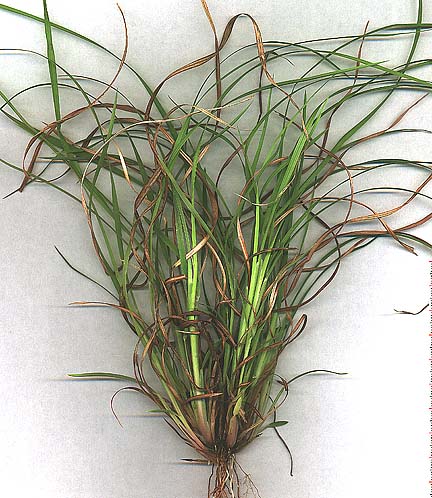 |
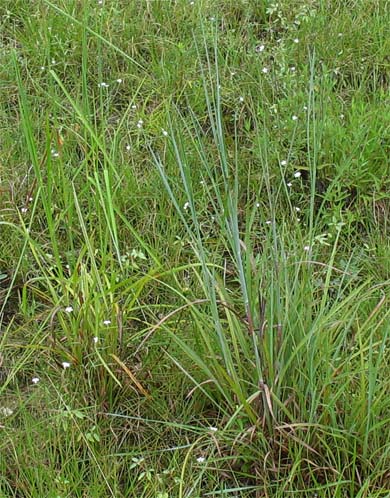 |
| A single tuft. | Blue variant (next to typical green form), July 2007. |
Leaf and Culm Features
With good moisture its leaves tend to be bright green, but under the stress of drought they turn orangish–red, as shown top right. A glaucous bluish form also occurs in a limited area of our land; even less common are plants with pubescent sheaths. It blooms from early to late fall (sometimes a bit earlier), and with frost its leaves turn a distinctive red. In all seasons its color is distinctive in comparison with other local grasses, and can be easily recognized at a distance.

Winter red clumps above a seep, with Muhlenbergia lindheimeri (Lindheimer muhly) and
Andropogon glomeratus (bushy bluestem), orange, in background).
In contrast to B. ischaemum its nodes and blades are not pubescent. The sheath has a clear keel, and may have long hairs. The ligule tends to be more prominent.
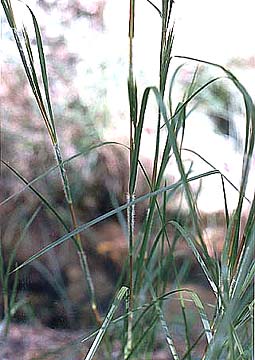 |
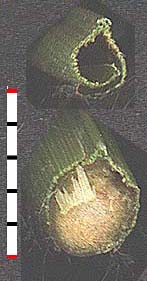 |
| Hairy sheaths form |
Cross section of sheath showing keel. |

A. Glaucescent culms; B. Typical culms with nodes, sheaths; C. Sheath with hairs; L. Ligule.
Inflorescence
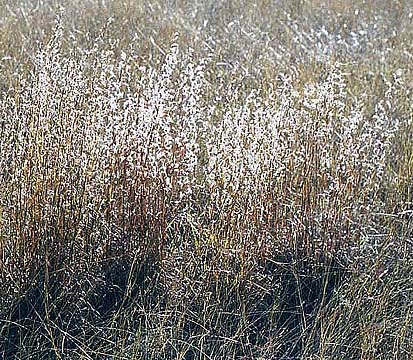
With ripe seeds in late fall.
Unique among our local bluestems, in bloom the culms have numerous lateral branches, each branch terminating with a single raceme of spikelet pairs, arising from the terminal leaf.
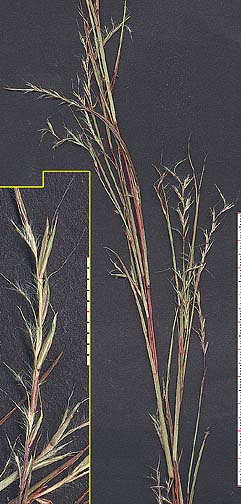 |
 |
| Many-branched inflorescence. |
Raceme arising from leaf. |
At anthesis the spikelets are closely appressed, and the awns have yet to develop their slightly bent and twisted form.
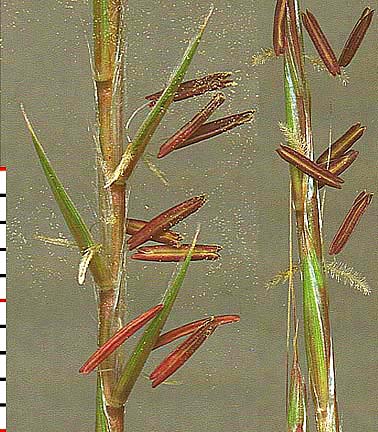 | 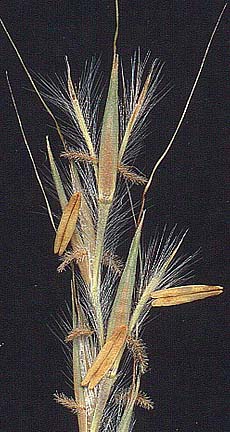 |
| Early anthesis. |
Later, awns more developed. |
Spikelets
Spikelet morphology of Schizachyrium, as with other grasses that are commonly called 'bluestem' such as the exotic 'King Ranch bluestem' (Bothriochloa ischaemum), is quite complex. (These grasses are in the tribe ANDROPOGONEAE. Named for the hairy spikelets, Greek andros 'man' and pogon 'beard.' In some treatments our local 'bluestems' continue in the genus Andropogon (along with Andropogon gerardii, big bluestem). An excellent presentation the spikelet morphology of this group is presented in The Flora of North America, vol. 25, available online as Manual of Grasses for North America; ANDROPOGONEAE).
The most salient and clearly visible feature for these genera is the arrangement of spikelet pairs along the raceme axis with an abscission layer between each pair. Each pair consists of a sessile spikelet, with an awn, and a rudimentary sterile spikelet, usually smaller, on a pedicel. When mature the raceme bearing the spikelets disarticulates at the abscission layer, in such a way that a spikelet pair plus the associated axis section separate as a unit.
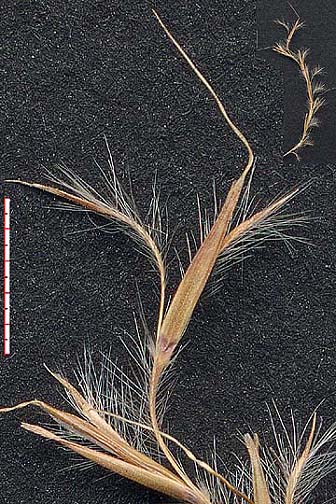 |
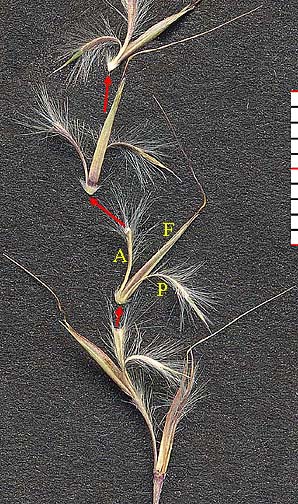 |
| Terminal spikelet pair. |
Disarticulation along axis.
A = axis segment, F = sessile (fertile) spikelet, P = rudimentary pedicellate spikelet.
|
The sessile spikelet contains two florets concealed by its two glumes. One floret is fertile with an awn extending its central nerve; the other floret is sterile. The pedicellate spikelet is rudimentary.
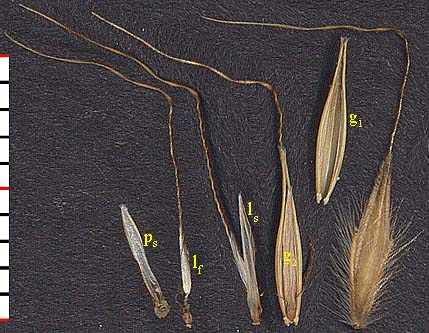
Dissected sessile spikelet. g1 = first glume, g2 = second glume,
lf = lemma of fertile floret, ls = lemma of sterile floret, ps = palea of sterile floret.
Seed (Spikelet) Dispersal
The hairy rudimentary spikelet and hairy axis segment create an aerodynamic unit with limited capacity for dispersal in the wind. Rice et. al (1960) found that with a prevailing south wind seeds of S. scoparium were found 6 feet distant to the north of an established clump, fewer were found 6 feet distant to its south.
Additional supporting dispersal features are the relatively loose bond at the axis joints when the spikelets are dry, disarticulating in a strong wind. Walking through a field with dry inflorescences seems sufficient to dislodge a few spikelets. And the height of the flowering culm favors a longer dispersal distance.
Although these aspects of S. scoparium morphology would seem better suited for dispersal than those of B. ischaemum, spread of S. scoparium would still be limited to the edges of its territory, and replacing adjacent B. ischaemum could still take a long time (even with favorable weather).